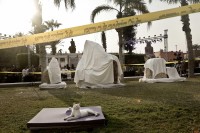 The colossal statue discovered in the Matariya neighborhood of Cairo on March 7th is not of Pharaoh Ramesses II, Egypt’s Minister of Antiquities Khaled El-Enany announced at a press conference Thursday. When the head and bust of the statue were unearthed, the massive scale and style suggested it might be a depiction of Ramesses the Great, who was fond of having giant sculptures of himself made. He built extensively in the sacred city of Heliopolis whose remains underly Matariya.
The colossal statue discovered in the Matariya neighborhood of Cairo on March 7th is not of Pharaoh Ramesses II, Egypt’s Minister of Antiquities Khaled El-Enany announced at a press conference Thursday. When the head and bust of the statue were unearthed, the massive scale and style suggested it might be a depiction of Ramesses the Great, who was fond of having giant sculptures of himself made. He built extensively in the sacred city of Heliopolis whose remains underly Matariya.
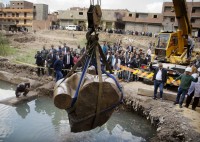 After causing much controversy by removing the massive head of the statue from the muddy pit using a bulldozer, archaeologists took a kinder, gentler approach with the torso. It was strapped to a crane and slowly lifted out of the waterlogged trench on March 13th. The torso alone weighs three tons, the head 1.5 tons. The weight of the complete statue could have been as much as 50 tons; the estimated height is nine meters (30 feet).
After causing much controversy by removing the massive head of the statue from the muddy pit using a bulldozer, archaeologists took a kinder, gentler approach with the torso. It was strapped to a crane and slowly lifted out of the waterlogged trench on March 13th. The torso alone weighs three tons, the head 1.5 tons. The weight of the complete statue could have been as much as 50 tons; the estimated height is nine meters (30 feet).
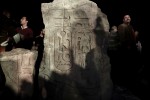 When the head was moved, archaeologists noticed some stylistic features characteristic of later periods. Then, on the back pillar of the statue they found an inscription with key evidence for a very different and much later identification: Pharaoh Psamtek I.
When the head was moved, archaeologists noticed some stylistic features characteristic of later periods. Then, on the back pillar of the statue they found an inscription with key evidence for a very different and much later identification: Pharaoh Psamtek I.
Mr el-Anani, speaking at the famed Egyptian museum in the heart of Cairo, said they were lucky to spot an inscription of one of Psamtek’s five names on the statue.
“It’s a part of the royal protocol, each pharaoh had five titles followed by five names,” he said.
“We were lucky to find the second title — the Nepti title — drawn with a vulture and a cobra, followed by the name Neb Aa.
“Neb Aa means the possessor of the arm, which means the mighty.”
The only pharaoh who was referred to as Neb Aa was the Pharaoh Psamtek I from the 26th Dynasty who ruled Egypt for 54 years.
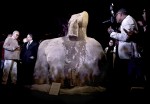 Ramesses reigned from 1279–1213 B.C., more than 600 years before Psamtek I (664–610 B.C.) ascended the throne. Psamtek would have good reason to want to be associated with one of Egypt’s most successful and best remembered pharaohs. He too was a highly effective ruler, both military and political. Founder of the 26th Dynasty, Psamtek I kicked out the Assyrians after 17 years of occupation and reunified Egypt. His reign, almost as long as Ramesses’, was something of a renaissance for Egypt, a revival of its ancient glories, albeit in much diminished form. Psamtek and his successors deliberately sought to emulate the iconography of Old Kingdom Egypt.
Ramesses reigned from 1279–1213 B.C., more than 600 years before Psamtek I (664–610 B.C.) ascended the throne. Psamtek would have good reason to want to be associated with one of Egypt’s most successful and best remembered pharaohs. He too was a highly effective ruler, both military and political. Founder of the 26th Dynasty, Psamtek I kicked out the Assyrians after 17 years of occupation and reunified Egypt. His reign, almost as long as Ramesses’, was something of a renaissance for Egypt, a revival of its ancient glories, albeit in much diminished form. Psamtek and his successors deliberately sought to emulate the iconography of Old Kingdom Egypt.
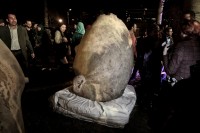 Despite the strong evidence of the unique title in the inscription, Enany won’t categorically state that the statue depicts Psamtek I at this juncture, a wise choice in the wake of the overly enthusiastic Ramesses claims. First the excavation team must finish their exploration of the site. There may be more fragments still to be found there. A close study of the inscription and pieces will hopefully answer some of the questions about its age and identity. For instance, what if it’s both Ramesses and Psamtek? There’s an outside chance the latter recycled a statue of his great predecessor, altering it to make it resemble him more and adding the inscription.
Despite the strong evidence of the unique title in the inscription, Enany won’t categorically state that the statue depicts Psamtek I at this juncture, a wise choice in the wake of the overly enthusiastic Ramesses claims. First the excavation team must finish their exploration of the site. There may be more fragments still to be found there. A close study of the inscription and pieces will hopefully answer some of the questions about its age and identity. For instance, what if it’s both Ramesses and Psamtek? There’s an outside chance the latter recycled a statue of his great predecessor, altering it to make it resemble him more and adding the inscription.
If the identification and dating is confirmed, the colossus will be far and away the best surviving example of an Old Kingdom throwback from Psamtek’s reign. More than that, it will be the largest statue from the Late Period (664-332 B.C.) ever found.
The most urgent issue is the stabilization of the statue fragments. The sudden change in environment from the mud and wet below the water table to the desert heat of the surface can damage the quartzite stone. Cairo Museum conservators will spend at least three months helping the statue adjust to its new circumstances.
Hey! That cat’s trespassing!
It’s Bastet. She’s waiting for the next gaum with a bulldozer to unsheath her claws.
Indeed, just a matter of feline supervision:
Good to see that her subjects seem to have provided her -on time- with at least a cozy polyethylene foamed mattress.
Rituals honoring ‘Bastet’ usually include light-hearted processions and orgiastic ceremonies, which seemingly leaves still room for further improvement here.
🐱🐱🐱🐱🐱🐱🐱
So he [Psammetichos], perceiving that the saying of the Oracle was coming to pass, dealt in a friendly manner with the Ionians and Carians, and with large promises he persuaded them to take his part. Then when he had persuaded them, with the help of those Egyptians who favoured his cause and of these foreign mercenaries he overthrew the kings. Having thus got power over all Egypt, Psammetichos made for Hephaistos that gateway of the temple at Memphis which is turned towards the South Wind. …
[Psammetichos] built a court for Apis, in which Apis is kept when he appears, opposite to the gateway of the temple, surrounded all with pillars and covered with figures; and instead of columns there stand to support the roof of the court colossal statues twelve cubits high. Now Apis is in the tongue of the Hellenes Epaphos. …
Now the Ionians and Carians occupied these portions of land for a long time, and they are towards the sea a little below the city of Bubastis [Cats!], on that which is called the Pelusian mouth of the Nile.
Just further proof that cats have always ruled.
love the cat….and the other stuff too.
OK, so the beautiful lounging cat is a reminder of a previous attempt to move the statue with Cat er Pillar excavator :yes: So, it is one cat or another.
True CATharsis ..>^.^<.. Bubastis ('Per-Bastet') and the cult of the cat [the yearly cat festival, note that parallels to current Egyptian folklore, plus the garments in public, are probably (not) coincidental]:
“Some of the women have rattles and rattle with them, while some of the men play the flute during the whole time of the voyage, and the rest, both women and men, sing and clap their hands; and when as they sail they come opposite to any city on the way they bring the boat to land, and some of the women continue to do as I have said, others cry aloud and jeer at the women in that city, some dance, and some stand up and pull up their garments. This they do by every city along the river-bank; and when they come to Bubastis they hold festival celebrating great sacrifices, and more wine of grapes [and probably Beer] is consumed upon that festival than during the whole of the rest of the year.” (Herodotus, Bk, II 60)
That is a fine looking cat. Until I enlarged the picture I thought, “That has to be the finest existing marble cat sculpture from antiquity ever recovered!” It’s obviously time to get new glasses.
I’ve got this down as misidentified Pharaoh #398 since modern archaeology emerged in the early 20th century. Anyone else have a different count?